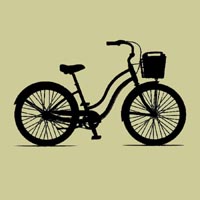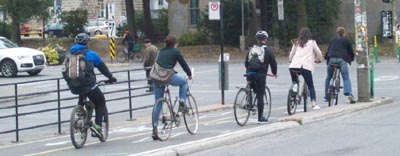How to adjust the saddle and handlebar of your bicycle
Rule for efficient and comfortable pedaling

THE RIGHT HEIGHT: when your heel is over the pedal axis your leg
is fully extended. When pedaling normally with the ball of the foot your
leg has a small bend of around 30 degrees for maximum power.

Make sure the saddle is leveled and parallel to the ground.
Images from "La bicyclette" by Jean Corbeil, Éditions de l'homme,
1980
.jpg)
At a stop you must come down from the saddle to touch the ground. This
cyclist is in the right position to start riding, one foot on the ground and
the other on a raised pedal. On the first pedal stroke he will raise himself
by pushing on the pedal and then sit back.
.jpg)
MUCH TOO LOW: This young man can touch the ground with his feet flat while
sitting on the saddle. When he pedals his legs are always bent, loosing much
of his effort, it hurts to the buttocks and knees, he must stand up on the pedals
to accelerate.
- First check that the saddle is level, parallel to the ground, not inclined forwards or backwards. Check that the saddle is aligned with the frame centerline, not pointing left or right.
- When pedaling your leg should be almost fully extended when the pedal is at the farthest point. What is "almost fully extended" ? When you pedal normally, with the front part of the foot, there is a very slight flexion of the knee of around 30 degrees, but if you place your heel over the pedal axis, your leg is completely straight.
- Pay attention to the maximum height engraved on the seat post: there is a line engraved indicating the maximum height (or minimum insertion in the frame). If you exceed the limit you may bend the seat post and / or the frame which is fatal . You can change the seat post for a longer one, but the bike may be too small for you. See the article Which bike size you need.
- Contrary to what many people believe, if your feet can touch the ground while seated, the saddle is too low . If your saddle is at the right height your feet do not reach the ground and you must descend from the saddle at a stop (see photo above).
- To start, place yourself between the saddle and the handlebars, with one foot on the ground and the other on a raised pedal (see photo above). If necessary, raise a pedal by counter-pedaling with the top of your foot. Take a little momentum by pushing on the pedal and get on the saddle with the first pedal stroke .
- At a stop you must descend from the saddle by sliding forward and landing between the saddle and the handlebar (see photo above).
Inexperienced cyclists, children, urban use, winter bike
- It is preferable to adjust the saddle a little lower to touch the ground with tiptoe for beginners, children, for dense urban areas where stops are frequent, and to ride in winter when the risks of sliding are great. You lose power but it is safer because you can stay on the saddle at stops.
- Even for beginners, you should not adjust the seat such that your two feet are flat on the ground at a stop. This way of adjusting the saddle is much too low, the pedaling is so uncomfortable and inefficient that beginners won't even be able to ride and learn. It gives you cramps, knee pains, your butt will suffer, and everyone will be faster than you!

Adjust the saddle lower for inexperienced cyclists,
to touch the ground with tiptoe.
BMX's and mountain bikes
The rule above does not apply to BMX for acrobatics. Also the saddle is adjusted
lower for mountain biking off-road on rough terrain. High quality mountain bikes
have quick releases to easily adjust the saddle according to the terrain.
If the bike is too small
- It is possible to change the seat post for a longer one if necessary.
- Seat posts are manufactured in several different diameters, with increments as small as 0.1mm. The diameter is usually etched in the metal, for example 25.8 mm. One can't simply take a longer seat post from another bike, it must be replaced by a post of exactly the same diameter. If you are not sure because the numbers are illegible, bring your seat post to the store to have it measured with a micrometer. We can't perceive a difference of 0.1mm with fingers!
Adjusting the height and angle of the handlebar
- The angle of the handlebar must be adjusted such that the handles are parallel to the ground or slightly inclined towards the cyclist. Too high an angle is dangerous because your hands may slip under shock.
- On most bicycles there is little adjustment for the height of the handlebar, unlike the height of the saddle. The height of the handlebar can be adjusted only a few centimeters.
- There is a line engraved on the bracket indicating the maximum height (or minimum insertion in the frame). If you exceed the limit you risk bending the stem and/or the frame of the bike, which is fatal .
- The height of the handlebar depends on the type of bike and the style of position you prefer. In general the handlebars must be at the same height as the saddle or higher.
- A raised handlebar is more comfortable and provides better visibility, but it's less aerodynamic, so your top speed is lower.
- On the road bikes the handlebars can be adjusted lower than the saddle for an aggressive position leaning forward, to cut air resistance and go faster.

On road bikes the angle should 10 degrees
Illustrations tirées de "La bicyclette" par Jean Corbeil, Éditions
de l'homme, 1980

